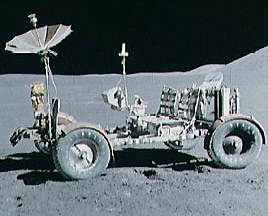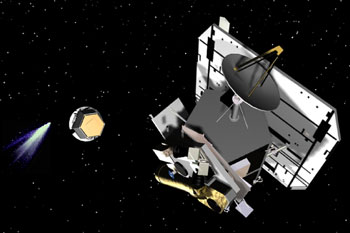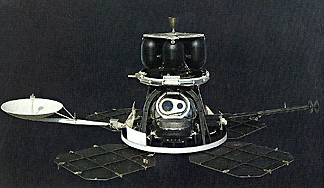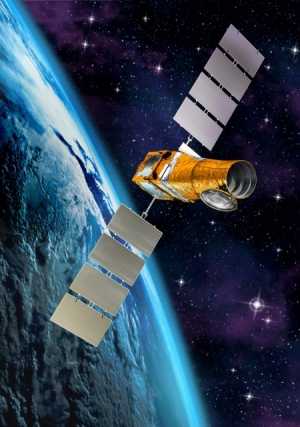An artist's concept of the CoRoT satellite in orbit.
Click on image for full size
CNES / D. Ducros
Related links:
CoRoT website
CoRoT - Searching for distant worlds
The European Space Agency recently launched a satellite to study
convection and rotation in
pulsating stars. The mission will also look for
planets that "transit" these distant stars. Scientists from France named
the satellite CoRoT -- for Convection, Rotation, and planetary Transits.
CoRoT will measure the amount of light coming from many stars over
time. Some of these stars will have planets around them. Some of those
planets might pass in front of the star. This will cause a brief drop in the amount of light CoRoT sees. The drops must happen over and over from
the same star. The color of the light should not change, and the shape
of the drop must be right. Then it could be a planet.
Even planets the size of Earth might be found with CoRoT. This is about 10
times smaller than the smallest planets found by telescopes on the ground.
What if it finds a planet like the Earth? We can begin looking for signs
of liquid water, green plants, and maybe even intelligent life!
You might also be interested in:

The Hubble Space Telescope (HST) was one of the most important exploration tools of the past two decades, and will continue to serve as a great resource well into the new millennium. The HST found numerous
...more
Driven by a recent surge in space research, the Apollo program hoped to add to the accomplishments of the Lunar Orbiter and Surveyor missions of the late 1960's. Apollo 11 was the name of the first mission
...more
Apollo 12 was launched on Nov. 14, 1969, surviving a lightning strike which temporarily shut down many systems, and arrived at the Moon three days later. Astronauts Charles Conrad and Alan Bean descended
...more
Apollo 15 marked the start of a new series of missions from the Apollo space program, each capable of exploring more lunar terrain than ever before. Launched on July 26, 1971, Apollo 15 reached the Moon
...more
NASA chose Deep Impact to be part of a special series called the Discovery Program on July 7, 1999. The Discovery program specializes in low-cost, scientific projects. In May 2001, Deep Impact was given
...more
The Galileo spacecraft was launched on October 19, 1989. Galileo had two parts: an orbiter and a descent probe that parachuted into Jupiter's atmosphere. Galileo's main mission was to explore Jupiter and
...more
During 1966 through 1967, five Lunar Orbiter spacecrafts were launched, with the purpose of mapping the Moon's surface in preparation for the Apollo and Surveyor landings. All five missions were successful.
...more















